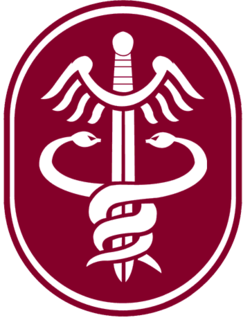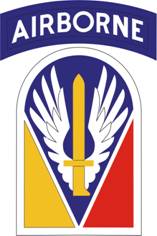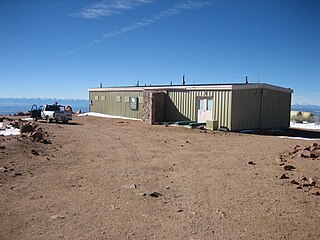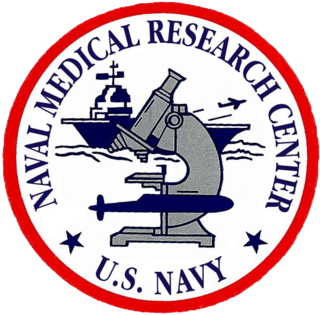Related Research Articles
The Combat Capabilities Development Command (CCDC) Soldier Center, now CCDC SC was formerly the United States Army Natick Soldier Research, Development and Engineering Center, and is a tenant unit of the United States Army Natick Soldier Systems Center (SSC), or Soldier Systems Center Natick. CCDC SC is a military research complex and installation in Natick, Massachusetts charged by the U.S. Department of Defense with the research and development of food, clothing, shelters, airdrop systems, and other servicemember support items for the U.S. military. The installation includes facilities from all the military services, not just the Army, and is so configured to allow cross-service cooperation and collaboration both within the facility and with the many academic, industrial and governmental institutions in the Greater Boston Area.

The U.S. Army Medical Command (MEDCOM) is a direct reporting unit of the U.S. Army that formerly provided command and control of the Army's fixed-facility medical, dental, and veterinary treatment facilities, providing preventive care, medical research and development and training institutions. On 1 October 2019, operational and administrative control of all military and veteran medical facilities transitioned to the Defense Health Agency.

The Army Medical Department of the U.S. Army (AMEDD), formerly known as the Army Medical Service (AMS), encompasses the Army's six medical Special Branches. It was established as the "Army Hospital" in July of 1775 to coordinate the medical care required by the Continental Army during the Revolutionary War. The AMEDD is led by the Surgeon General of the U.S. Army, a lieutenant general.
Environmental medicine is a multidisciplinary field involving medicine, environmental science, chemistry and others, overlapping with environmental pathology. It can be viewed as the medical branch of the broader field of environmental health. The scope of this field involves studying the interactions between environment and human health, and the role of the environment in causing or mediating disease. This specialist field of study developed after the realisation that health is more widely and dramatically affected by environmental factors than previously recognized.

Fort Polk is a United States Army installation located in Vernon Parish, approximately ten miles (15 km) east of Leesville, Louisiana, and thirty miles (50 km) north of DeRidder in Beauregard Parish, Louisiana.

The U.S. Army Research Institute of Environmental Medicine (USARIEM) is the U.S Army’s main institution and facility for military environmental medicine and exercise physiology research. It is located at Natick, Massachusetts, within the U.S. Army Soldier Systems Center (SSC) installation, but is a subordinate lab of the U.S. Army Medical Research and Materiel Command (USAMRMC), headquartered at Fort Detrick, Maryland, USA.

The U.S. Army Pikes Peak Research Laboratory, or simply the "Pikes Peak Lab", is a modern medical research laboratory for the assessment of the impact of high altitude on human physiological and medical parameters of military interest. It is a satellite facility of the U.S. Army Research Institute of Environmental Medicine (USARIEM), located in Natick, Massachusetts. The Pikes Peak Lab is at the summit of Pikes Peak 14,115 feet (4,302 m) in central Colorado, USA. The summit is approximately 5 acres (2.0 ha) of relatively flat, rocky terrain and is directly and easily accessible by automobile via the Pikes Peak Highway.

The Walter Reed Army Institute of Research (WRAIR) is the largest biomedical research facility administered by the U.S. Department of Defense (DoD). The institute is centered at the Forest Glen Annex, in the Forest Glen Park part of the unincorporated Silver Spring urban area in Maryland just north of Washington, DC, but it is a subordinate unit of the U.S. Army Medical Research and Development Command (USAMRDC), headquartered at nearby Fort Detrick, Maryland. At Forest Glen, the WRAIR has shared a laboratory and administrative facility — the Sen Daniel K. Inouye Building, also known as Building 503 — with the Naval Medical Research Center since 1999.

The 311th Human Systems Wing is an inactive wing of the United States Air Force. It was stationed at Brooks City-Base in San Antonio, Texas.

The term military medicine has a number of potential connotations. It may mean:
The United States Army Medical Research and Development Command (USAMRDC) is the United States Army's medical materiel developer, with responsibility for medical research, development, and acquisition and medical logistics management. The USAMRDC's expertise in these critical areas helps establish and maintain the capabilities the U.S. Army needs to fight and win on the battlefield.

Lester Martínez López is the first Hispanic to head the Army Medical and Research Command at Fort Detrick, Maryland. His responsibilities included overseeing the Army Medical Research Institute of Infectious Disease, which develops antidotes and vaccines for diseases soldiers might face on the battlefield.

The U.S. Army Public Health Center (APHC) is a United States Army element headquartered at Aberdeen Proving Ground, Maryland, United States. As a forward operating agency of the United States Army Medical Command, APHC is responsible for providing technical support and expertise in the areas of preventive medicine, public health, health promotion, and wellness to military units around the globe.
AMRL may refer to:
Based on advances in food research technology, and methodologies for the improvement of U.S. military soldiers' overall health and nutritional status, the history of military nutrition in the United States can be roughly divided into seven historical eras, from the founding of the country to the present day. Through the research and guidance of medical and military professionals, rations and packaging have been consistently and dramatically improved.

The Naval Medical Research Center (NMRC) is an agency that performs basic and applied biomedical research to meet the needs of the United States Navy and United States Marine Corps. Its areas of focus include study of infectious diseases, biodefense, military medicine, battlefield medicine, and bone marrow research. NMRC is under the United States Department of the Navy's Bureau of Medicine and Surgery.

Robert J. T. Joy was an American physician and career Army Medical Corps officer who was an internationally recognized scholar in the field of the History of Medicine. He was also a key leader in U.S. Department of Defense Medical Research and Development, and served as one of the key founding staff members of the Uniformed Services University of the Health Sciences, where he served as the first Commandant of Students, Chair of the Department of Military Medicine, and, after his retirement from military service, first Professor and Chair of the Section or Medical History at the University.

Jay Y. Gillenwater is professor emeritus at the University of Virginia. He is former chair of the Department of Urology at the School of Medicine of the University of Virginia, was president of the American Urological Association, editor of the Journal of Urology, member of the NIH Advisory Council of Diabetes, Digestive, and Kidney Diseases, and president of the American Foundation for Urologic Diseases. He is the author of Adult and Pediatric Urology.
References
- ↑ Dr. Sanders Marble (July–September 2015). "Making Tanks Safe: Armored Force Medical Research Laboratory" (PDF). eARMOR.
- ↑ "U.S. Army Research Institute of Environmental Medicine - Our History". USARIEM.